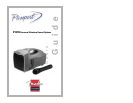
P250) equipped with wireless receivers are set up throughout the termi-
nal. As the agent announces events taking place at that gate, everyone in
the terminal can also hear the information.
Using the secondary 1/4” microphone input
- You must use a microphone that has a cable with a 1/4” connector. Plug
the 1/4” end of the mic cable into the 1/4” Input Jack on the
P10W (#3).
- Adjust the 1/4” input level control (#6) to desired volume.
Connecting another audio source to the P10W
- The 1/8” Auxiliary input jack (#7) is available to connect a CD or
Cassette player to the P10W.
- Connect the device’s audio output to the 1/8” Auxiliary Input on
the P10W.
- Turn the Volume Control (#4) clockwise to turn on the P10W, and
adjust to desired volume.
Connecting the line output to another piece of equipment
The 1/8” line output is available to send the audio signal(s) from the
P10W to another piece of equipment. For example, if you want to
record a presentation (or you singing!) you can connect this output
jack to the input jack of a cassette recorder.
The level of the audio from this jack is adjusted with the wireless
mic (main) volume control (#4).
Charging the Battery
Very Important! - Before you use your P10W, you must charge
the battery for at least four hours (or until the Battery Charge
Indicator indicates the battery is fully charged).
The P10W has an auto turn-off protection circuit. When the battery
charge is weak, the unit will automatically turn off to prevent damaging
the battery. If this happens, turn off the unit and recharge the battery.
AC to DC power adapter
A power adapter is supplied with your P10W. This adapter is used to
recharge the battery. It is not designed to power the P10W from an AC
source. Make sure the P10W is turned off when recharging the battery.
Operation
Very Important! - Before you use your P10, you must charge the bat-
tery for at least four hours (or until the Battery Charge Indicator indi-
cates the battery is fully charged)
Using the wireless microphone
The wireless microphone runs off a 9v battery (not included). Unscrew
the cylindrical end of the mic to access the battery compartment.
- Turn on the P10W
- Turn on the wireless microphone
- Adjust the volume control (#4) to the desired volume.
The wireless microphone included with your P10W is a high-quality
microphone designed for use with voice or instruments. The receiver is
built into the P10W. The transmission range (how far away you can move
the microphone away from the receiver) is well over 60 feet. Keep in
mind that many household and office appliances, as well as overhead flo-
rescent lights, or lights on dimmer switches can cause interference with
your wireless transmission. If this happens, simply move the P10W or
move the microphone to an area where you receive clear transmission. In
most cases, this should be no more than a few feet.
Wireless Flexibility - The Passport Way
The P10W is available in two wireless frequencies - 169.505MHz and
171.905MHz. The wireless frequency of your P10W is printed on the bot-
tom of the microphone and the bottom of the main unit. These same fre-
quencies are available as wireless systems for other Passport products.
The output of the wireless microphone (the transmitter) is sent all around
you. This means that if you had several P10W’s (all the same frequency)
they would all receive the signal from your microphone. Think of it as a
paging system - put P10’s in every room of your house or office and
when you speak into the microphone, your voice comes out of all the
speakers - each with their own volume controls!
A powerful feature is that one microphone can send signals to different
Passport systems. For example, an airline ticketing agent is using a P10W
as a communication tool at thier gate. Larger Passport systems (P150 or








